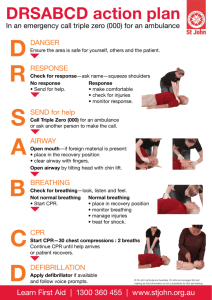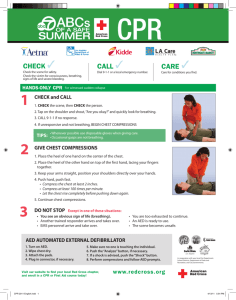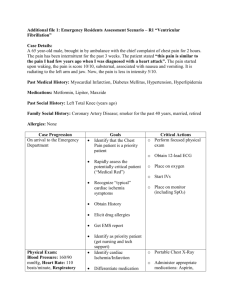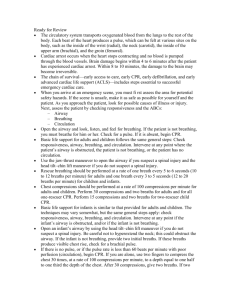Child CPR - Pages - Patient Education
advertisement
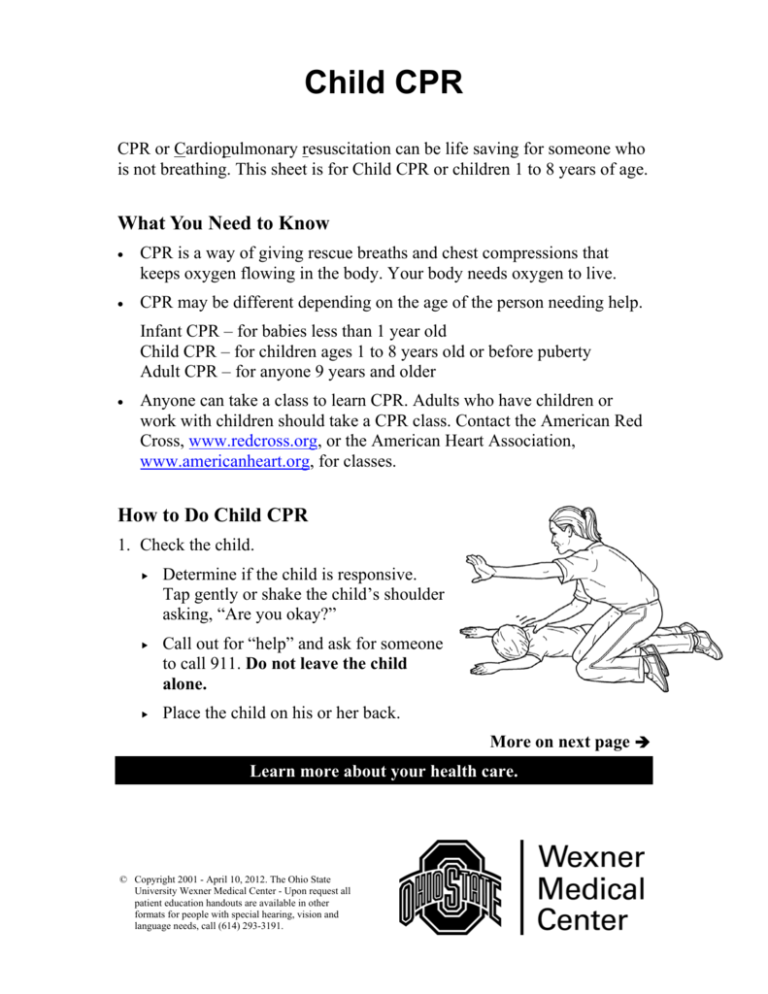
Child CPR CPR or Cardiopulmonary resuscitation can be life saving for someone who is not breathing. This sheet is for Child CPR or children 1 to 8 years of age. What You Need to Know CPR is a way of giving rescue breaths and chest compressions that keeps oxygen flowing in the body. Your body needs oxygen to live. CPR may be different depending on the age of the person needing help. Infant CPR – for babies less than 1 year old Child CPR – for children ages 1 to 8 years old or before puberty Adult CPR – for anyone 9 years and older Anyone can take a class to learn CPR. Adults who have children or work with children should take a CPR class. Contact the American Red Cross, www.redcross.org, or the American Heart Association, www.americanheart.org, for classes. How to Do Child CPR 1. Check the child. Determine if the child is responsive. Tap gently or shake the child’s shoulder asking, “Are you okay?” Call out for “help” and ask for someone to call 911. Do not leave the child alone. Place the child on his or her back. More on next page Learn more about your health care. © Copyright 2001 - April 10, 2012. The Ohio State University Wexner Medical Center - Upon request all patient education handouts are available in other formats for people with special hearing, vision and language needs, call (614) 293-3191. Page 2 2. Check for signs of child response. If child has no sign of response, there is no breathing or you are not sure, begin chest compressions. If child is breathing on his or her own, do not give chest compressions. 3. Begin chest compressions, if not breathing. Place heel of the hand on the lower half of the child’s breastbone just below their nipples. Press down on the chest ⅓ to ½ of the chest depth. Do this 30 times quickly. Stop CPR when the child shows signs of breathing on his or her own or when help arrives. 4. After 30 compressions, check for breathing. Put your ear close to the child’s nose and mouth. Look at the chest for movement. Listen for breathing from the nose and mouth. Feel for breaths on your ear. 5. If there is no breathing, open the airway to give 2 breaths. Kneel beside the child’s shoulder and lift the chin up gently with one hand while pushing down on the forehead with the other hand. This tilts the head back into a neutral position. Pinch the nostrils closed with the hand positioned on the forehead. Place your mouth over the child’s mouth. Give 2 breaths in 1 second. Page 3 Watch for the child’s chest to rise with the air you give. If it does not, the airway may be obstructed or the airway may need to be positioned again. Reposition and give 1 more breath. Take your mouth away from the child’s between each breath so the child can breathe out (exhale). 6. Call for help. If alone when starting CPR, continue for 2 minutes. After 2 minutes, Stop CPR long enough to call 911. Take the child with you unless you think there may be a back or spine injury. 7. Restart CPR. Continue CPR until the child starts breathing or until help arrives. Choking and Children 1 to 8 Years of Age If the child is having difficulty breathing or is choking, you will need to do something to remove the object that is blocking the airway. The child may be unable to speak or cough and may have his or her hands on their neck. This is the universal sign of choking. 1. Ask, “Are you choking?” 2. Stand behind the child. Make a fist with one hand and place the thumb side of your fist between the child’s navel and breast bone. Grasp your fist with your other hand. 3. Give 5 quick abdominal thrusts by pressing your fist in and upward. 4. Continue with abdominal thrusts until the object is removed and the child can breathe. 5. If the child becomes unconscious or is unable to breathe, begin CPR. Talk to your doctor or others on your health care team if you have questions. You may request more written information from the Library for Health Information at (614) 293-3707 or email: health-info@osu.edu.
